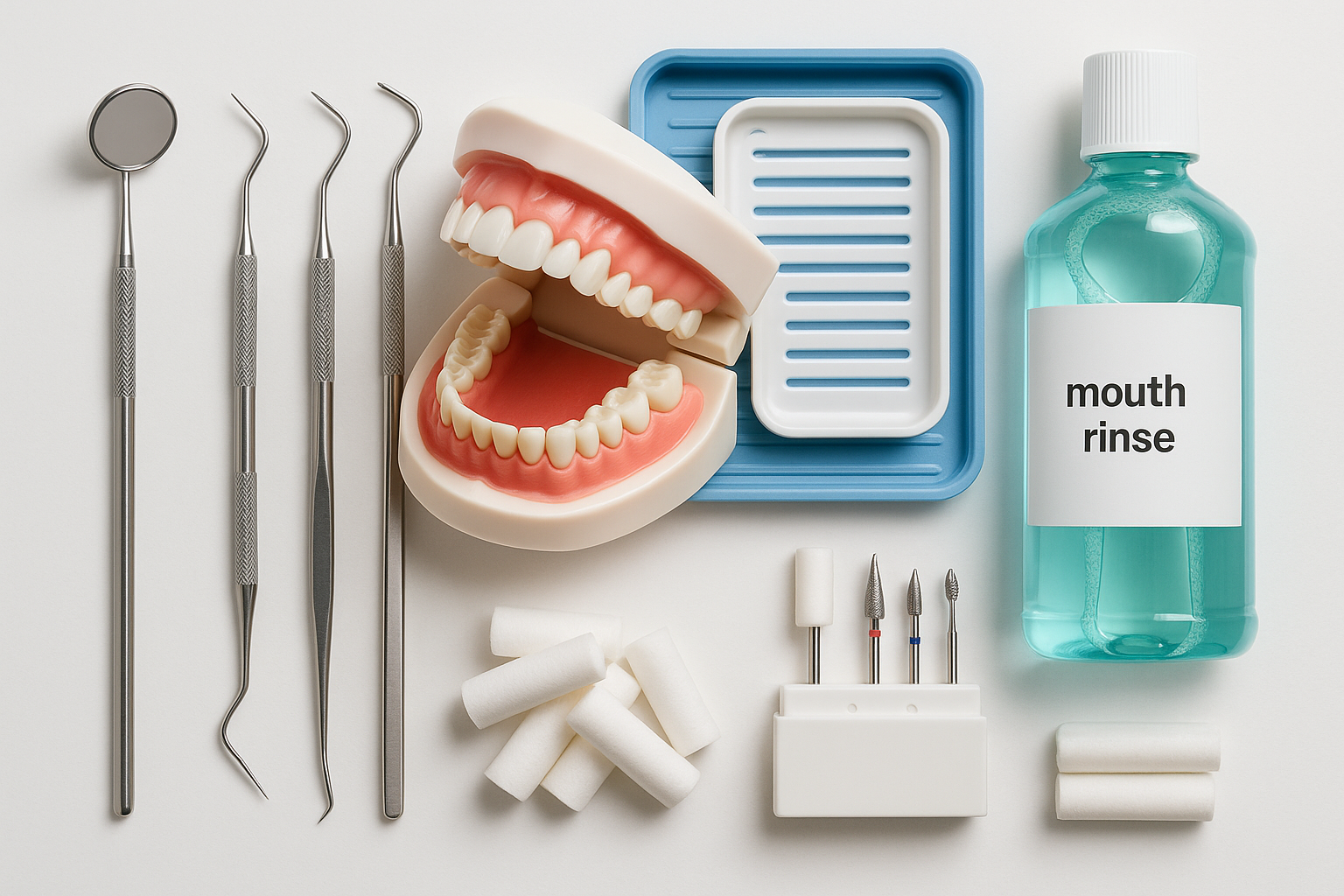Using the right impression materials is an important part of producing a good vs bad dental impression. So how do you choose between light body vs heavy body impression material for your dental office? The answer is you need both!
Most successful dental impressions use both light and heavy body impression material. Thin, free-flowing light body impression material captures every detail of the tooth. Thick, heavy body impression material provides a base for the light body material in the impression tray.
Whatever you use in your office, you can count on My DDS Supply for all your dental impression materials. We carry both light and heavy body impression material, in everything from PVS material to dental alginate.
What is Light Body Impression Material?
Light body impression material’s low viscosity allows it to flow into even small areas. Dentists typically apply light body material with a syringe for exact placement. The material hardens quickly in the patient’s mouth and produces a finely detailed mold of the treated area.
Purpose in Clinical Use
You’ll see light body impression materials used in high-precision work like crowns, bridges, and implants. Inaccurate impressions can result in an ill-fitting dental prosthesis that causes discomfort, irritation, or even difficulty chewing or swallowing.
Dentists can capture more of the important details with light body vs heavy body dental impression material. You also have greater control over material placement, which lets you center the final mold exactly where it needs to be.
Common Materials Available
Polyvinyl siloxane (PVS) is the most widely used light body material for dental impressions. PVS produces a mold that doesn’t shrink or distort when removed from the mouth. It captures details very well, and many patients find it tastes less unpleasant than alternative materials.
Some dentists prefer polyether, which performs well in the mouth’s wet environment. Polyether produces excellent casts even in the presence of saliva or blood. But because it becomes very rigid when set, you may run into difficulties when removing it from the casting area.
Agar, a hydrophilic gel, was traditionally used as both a light and heavy body impression material. Some dentists still use agar for finely detailed molds. But because agar requires specialized mixing and equipment, today dentists largely choose PVS or alginate vs agar.
What is Heavy Body Impression Material?
Heavy body impression material has a more putty-like texture. After applying the light body dental material, the dentist presses a tray loaded with heavy body impression material onto the replacement area.
The pressure forces the light body material into every crevice of the area, ensuring that every part is reflected in the final mold. When the heavy body material hardens (usually within 3 to 4 minutes), the mold is completed.
Purpose in Clinical Use
Doctors send the finished mold to a dental laboratory, where technicians create a gypsum cast of the tooth. This model lets the dentist see the replacement area from angles that are inaccessible in the patient’s mouth, and make sure everything is ready for the replacement.
After that examination, the dental laboratory can create a porcelain crown. Dentists can also use a heavy body dental mold when making a retainer, night guard, custom mouth guard, or bleaching tray.
Common Materials Available
Dentists often create retainer molds using alginate. Alginate is made from brown seaweed. Dentists traditionally used agar, a seaweed powder that became a stiff gel when mixed. But since preparing alginate vs agar is much easier, alginate has largely supplanted agar.
After mixing alginate with water to create a firm paste, they use it to produce an impression of the patient’s teeth. While it doesn’t reproduce every detail like a light body mold, it is accurate enough to make a well-fitting retainer.
PVS in dual mix cartridges or putty mix is another popular material. PVS putty from a dual mix cartridge is always properly mixed, while silicone putty mixed from powder can have bubbles and unmixed portions that lead to unusable molds.
Dual mix PVS is more common in dentists’ offices. But some dentists still prefer to mix their own putty, as the end result is thicker and firmer than dual mix. In either case, PVS is the most common choice for molds that require both light and heavy body impression material.
Light Body vs Heavy Body Impression Material: Key Differences to Consider
At the end of the day you need both light body and heavy body impression material in your practice. It’s just about understanding the role each plays. Here’s a quick guide to the important differences between light body vs heavy body impression material.
Viscosity and Flow Behavior
Viscosity is the key difference that separates light body vs heavy body impression material. Light body impression material has high viscosity and flows like a thick liquid. This allows it to seep over the mold area and provides a highly accurate image of the area.
Heavy body impression material is less viscous, with a texture more like soft clay. It can provide a base for the light body impression. It can also be used on its own to create molds suitable for many dental procedures.
Use in Dual-Viscosity Technique
When making a dual viscosity mold, dentists start by injecting a light body material around the affected area. They then mix a heavy body putty and place it in a tray. Often they smear a thin layer of the light body material over the putty to ensure complete coverage.
This produces a complete mold when they press the tray down over the area. The heavy body material supports the light body material, so you get a durable and detailed mold suitable for procedures where exact accuracy is important.
Detail Reproduction and Marginal Accuracy
The margin where the prepared tooth joins the crown, veneer, or onlay must be reproduced accurately. A replacement that is not perfectly sealed lets bacteria and saliva seep between the tooth and prosthetic. This can lead to decay, infection, and a shorter replacement life.
Creating properly fitting retainers or braces requires a very accurate mold. But you don’t necessarily need the microscopic levels of detail that you can get when using light body impression material. For these purposes, a heavy body mold is sufficient and more convenient.
Tray Seating and Pressure Distribution
A good dental impression must be complete and properly centered. It must also remain motionless during the 3-5 minutes required for the material to set fully. Pressure also ensures that the light body material seeps into every part of the tooth to get a full impression.
Improper pressure can result in voids or bubbles at critical areas. The tooth may break through the light body material, losing fine detail at a crucial point. A custom-made tray and proper technique can help ensure you get the best mold possible for your patient’s procedure.
Setting Times and Working Time Coordination
The dental impression material begins to harden as soon as you start the procedure. When you apply the light body material to the tooth or start mixing the heavy body material, you only have a short time before the material hardens and can no longer make an accurate impression.
But you also must make sure the material has fully hardened before you remove the impression tray. If you take it away too soon, the mold may be distorted and unusable.
Working with skilled assistants and coordinating the procedure carefully is crucial for making a proper mold and saving your patient a second dental visit.
When to Use One Without the Other
Dentists don’t always use light and heavy body impression materials to make a mold. Sometimes dentists create molds using only light body impression materials and an impression tray. This technique can be used for creating partial denture impressions, crowns, and bridges.
Heavy body impression molds are used for retainers and to test tooth alignment. Dentists use alginate or PVS for that purpose. Heavy body material impressions are more convenient and less stressful for the patient, as they only have to bite down and no syringe is needed.
Find All the Various Impression Materials Your Practice Needs at My DDS Supply!
When you’re doing replacement or orthodontic work, you need to have the proper materials at your fingertips. My DDS Supply is your one-stop shop for all your dental needs.
We carry a full line of impression materials for all your molding needs. We also have dental impression trays, temporary crown material, temporary dental cement, and all the supplies and accessories you need for your practice.
My DDS Supply delivers quality materials, fast shipping, and fair prices. Not sure what you need? Give us a call and our friendly and experienced customer support team will be happy to guide you.
Parting Thoughts on Light Body vs Heavy Body Impression Material
That does it for our discussion of light body vs heavy body impression materials. With the right materials and technique, you can create molds for every dental purpose. And when you shop at My DDS Supply, you’re always sure to have the appropriate materials on hand.
Our blog also offers helpful advice on important topics like how to avoid alginate impression errors or finding a good alginate alternative. We’re happy to help our customers with information that leads to greater patient satisfaction and a more efficient practice.
Upgrade your supplies and experience the My DDS Supply difference. We give you everything you need for happy patients and a thriving dental practice. Shop now or reach out for one-on-one support!

